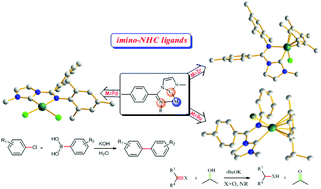Palladium (4a–4c), iridium (5a–5c) and ruthenium (6a–6c) complexes have been prepared by in situ transmetalation from the corresponding silver complexes of acyclic imino-functionalized imidazolium chlorides [1-(Me)-imidazolium-3-{C(p-CH3–Ph)![[double bond, length as m-dash]](https://www.rsc.org/images/entities/char_e001.gif) N(Ar)}]Cl (3) (Ar = 2,4,6-trimethylphenyl (3a), 2,6-diisopropylphenyl (3b) and phenyl (3c)) with [Pd(COD)Cl2], [Cp*IrCl2]2 or [Ru(p-cymene)Cl2]2, respectively. Iridium and ruthenium complexes, 5a[PF66]–5c[PF66], 6a[PF66]–6c[PF66], 6c[BF44], 6c[BPh44] and 6c[NTf222], were obtained directly from 5a–5c and 6a–6c through an anion-exchange process with KPF6, NaBF4, NaBPh4 and LiNTf2 (bis(trifluoromethylsulfonyl)imide lithium), respectively. All complexes were characterized by FT-IR, 1H and 13C NMR spectroscopy and elemental analysis. Crystal structures of 4a, 5a and 6c[NTf222] show that five-membered chelate ring is formed in these complexes by the coordination of the carbene carbon and the imino nitrogen atom, and the latter two are cationic compounds with Cl− and NTf2− as counteranion respectively. The catalytic performance of Pd complexes for Suzuki–Miyaura cross-coupling reactions in pure water and Ir and Ru complexes for transfer hydrogenation of ketones and imines was tested in a wide scope of substrates. Pd complex 4b with the largest steric hinder exhibited the best performance to gain moderate to excellent yields on catalyzing Suzuki–Miyaura cross-coupling of aryl chlorides and arylboronic acids in water. While in transfer hydrogenation of various ketones, all the Ir and Ru complexes were effective with good to excellent yields. Among all these complexes, 6c[PF66] was found most effective, and moderate yields could be obtained even in the transfer hydrogenation of imines. Moreover, different counteranions of Ru complexes are influential on catalyzing the transfer hydrogenation, with the sequence of PF6− ≈ BF4− > BPh4− > Cl− > NTf2−.
N(Ar)}]Cl (3) (Ar = 2,4,6-trimethylphenyl (3a), 2,6-diisopropylphenyl (3b) and phenyl (3c)) with [Pd(COD)Cl2], [Cp*IrCl2]2 or [Ru(p-cymene)Cl2]2, respectively. Iridium and ruthenium complexes, 5a[PF66]–5c[PF66], 6a[PF66]–6c[PF66], 6c[BF44], 6c[BPh44] and 6c[NTf222], were obtained directly from 5a–5c and 6a–6c through an anion-exchange process with KPF6, NaBF4, NaBPh4 and LiNTf2 (bis(trifluoromethylsulfonyl)imide lithium), respectively. All complexes were characterized by FT-IR, 1H and 13C NMR spectroscopy and elemental analysis. Crystal structures of 4a, 5a and 6c[NTf222] show that five-membered chelate ring is formed in these complexes by the coordination of the carbene carbon and the imino nitrogen atom, and the latter two are cationic compounds with Cl− and NTf2− as counteranion respectively. The catalytic performance of Pd complexes for Suzuki–Miyaura cross-coupling reactions in pure water and Ir and Ru complexes for transfer hydrogenation of ketones and imines was tested in a wide scope of substrates. Pd complex 4b with the largest steric hinder exhibited the best performance to gain moderate to excellent yields on catalyzing Suzuki–Miyaura cross-coupling of aryl chlorides and arylboronic acids in water. While in transfer hydrogenation of various ketones, all the Ir and Ru complexes were effective with good to excellent yields. Among all these complexes, 6c[PF66] was found most effective, and moderate yields could be obtained even in the transfer hydrogenation of imines. Moreover, different counteranions of Ru complexes are influential on catalyzing the transfer hydrogenation, with the sequence of PF6− ≈ BF4− > BPh4− > Cl− > NTf2−.
![[double bond, length as m-dash]](https://www.rsc.org/images/entities/char_e001.gif) N(Ar)}]Cl (3) (Ar = 2,4,6-trimethylphenyl (3a), 2,6-diisopropylphenyl (3b) and
N(Ar)}]Cl (3) (Ar = 2,4,6-trimethylphenyl (3a), 2,6-diisopropylphenyl (3b) and 

 Please wait while we load your content...
Please wait while we load your content...